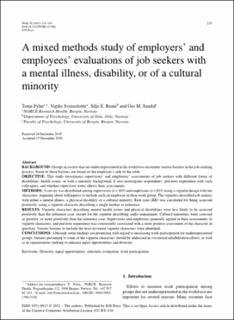| dc.contributor.author | Fyhn, Tonje | |
| dc.contributor.author | Sveinsdottir, Vigdis | |
| dc.contributor.author | Reme, Silje Endresen | |
| dc.contributor.author | Sandal, Gro Mjeldheim | |
| dc.date.accessioned | 2022-01-19T07:25:48Z | |
| dc.date.available | 2022-01-19T07:25:48Z | |
| dc.date.created | 2021-09-13T10:45:02Z | |
| dc.date.issued | 2021 | |
| dc.identifier.citation | Work : A journal of Prevention, Assesment and rehabilitation. 2021, 70 (1), 235-245. | en_US |
| dc.identifier.issn | 1051-9815 | |
| dc.identifier.uri | https://hdl.handle.net/11250/2838078 | |
| dc.description.abstract | BACKGROUND: Groups in society that are under-represented in the workforce encounter various barriers in the job-seeking process. Some of these barriers are found on the employer’s side of the table. OBJECTIVE: This study investigates supervisors’ and employees’ assessments of job seekers with different forms of disabilities, health issues, or with a minority background. It also investigates respondents’ previous experience with such colleagues, and whether supervisor status affects their assessments. METHODS: A survey was distributed among supervisors (n = 305) and employees (n = 925) using a vignette design with ten characters, inquiring about willingness to include such an employee in their work group. The vignettes described job seekers with either a mental illness, a physical disability or a cultural minority. Risk ratio (RR) was calculated for being assessed positively, using a vignette character describing a single mother as reference. RESULTS: Vignette characters describing mental health issues and physical disabilities were less likely to be assessed positively than the reference case, except for the vignette describing audio impairment. Cultural minorities were assessed as positive, or more positively than the reference case. Supervisors and employees generally agreed in their assessments of vignette characters, and previous experience was consistently associated with a more positive assessment of the character in question. Various barriers to include the least favoured vignette characters were identified. CONCLUSIONS: Although some findings are promising with regard to increasing work participation for underrepresented groups, barriers pertaining to some of the vignette characters should be addressed in vocational rehabilitation efforts, as well as in organizations seeking to enhance equal opportunities and diversity. | |
| dc.language.iso | eng | en_US |
| dc.rights | Navngivelse 4.0 Internasjonal | * |
| dc.rights.uri | http://creativecommons.org/licenses/by/4.0/deed.no | * |
| dc.title | A mixed methods study of employers' and employees' evaluations of job seekers with a mental illness, disability, or of a cultural minority | en_US |
| dc.type | Peer reviewed | en_US |
| dc.type | Journal article | en_US |
| dc.rights.holder | © The Authors, 2021 | |
| dc.description.version | publishedVersion | |
| cristin.ispublished | true | |
| cristin.fulltext | original | |
| cristin.qualitycode | 1 | |
| dc.identifier.doi | 10.3233/WOR-213568 | |
| dc.identifier.cristin | 1933664 | |
| dc.source.journal | Work : A journal of Prevention, Assesment and rehabilitation | en_US |
| dc.source.volume | 70 | en_US |
| dc.source.issue | 1 | en_US |
| dc.source.pagenumber | 235-245 | en_US |

